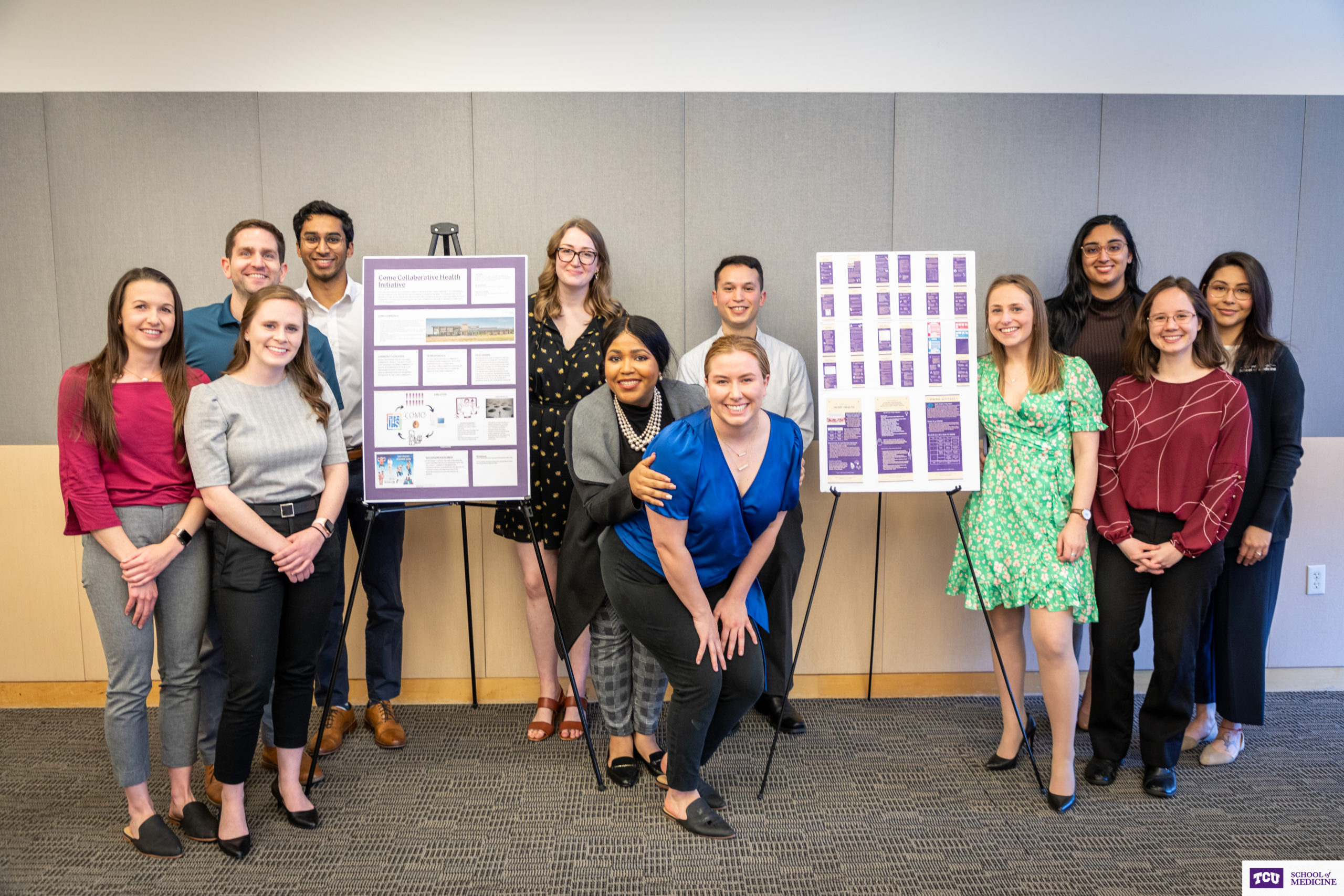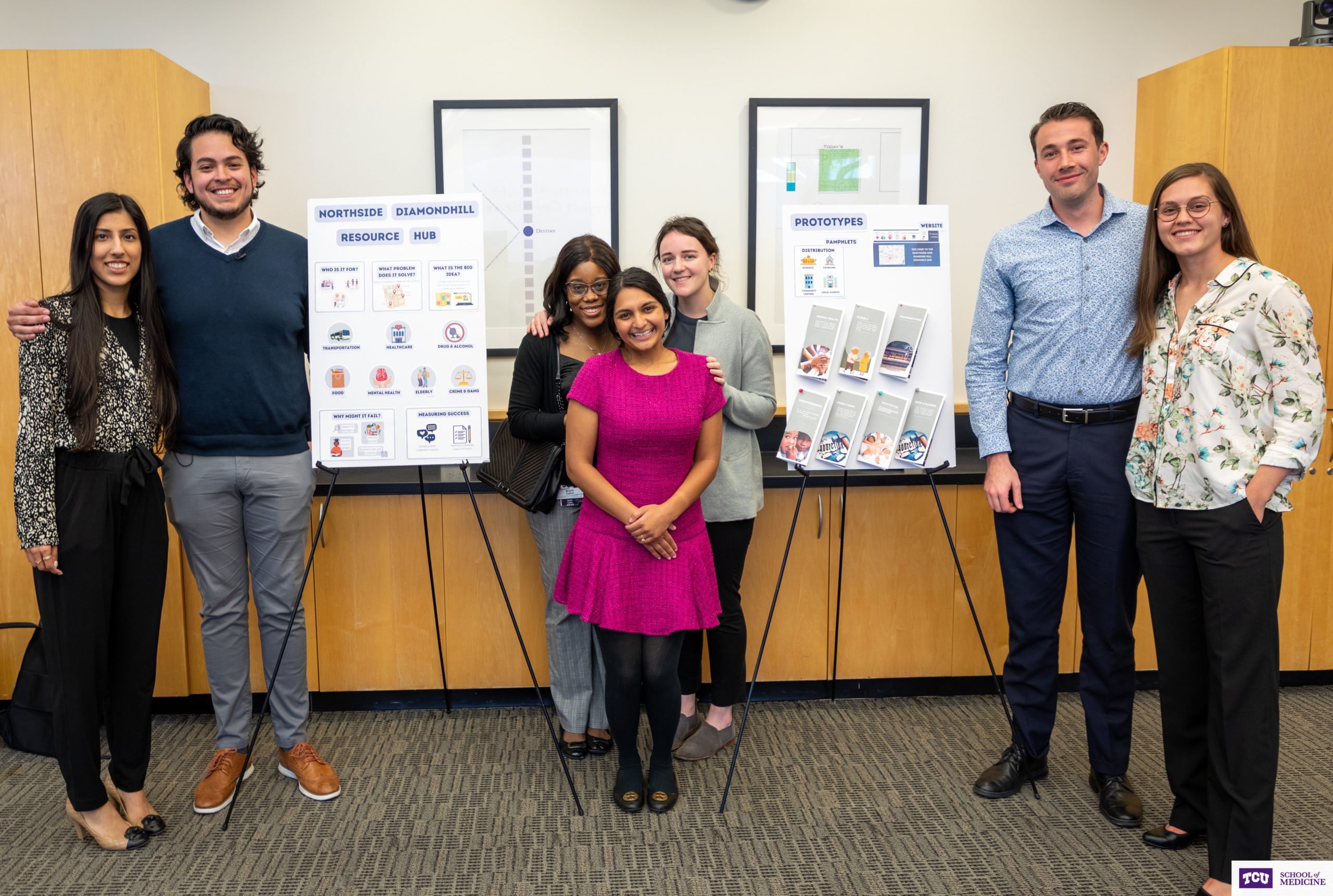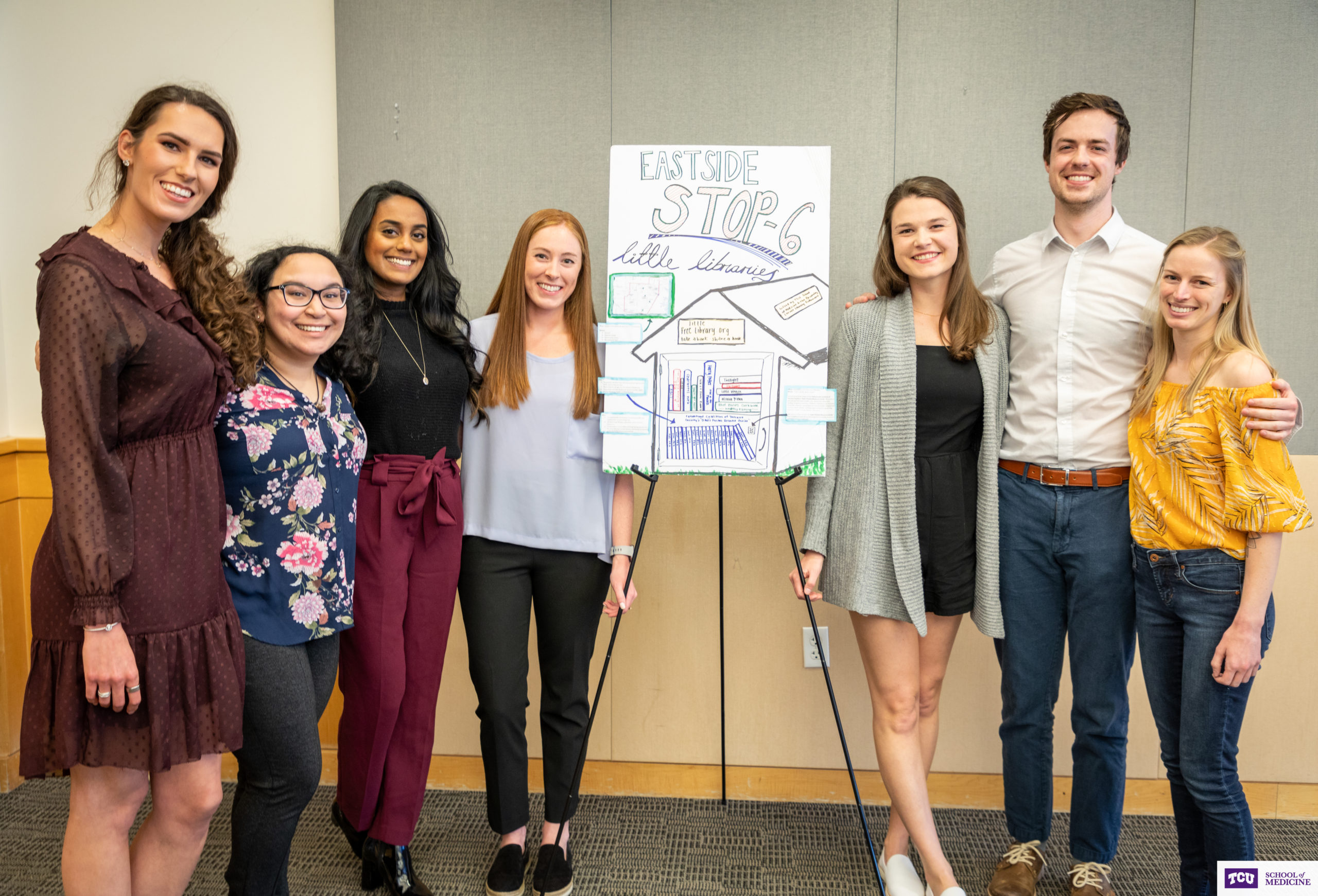TCU School of Medicine Collaborates With Fort Worth Neighborhoods To Make An Impact On Health Care
Medical students worked with Como, Northside/Diamond Hill and Eastside/Stop Six community leaders for the Community Impact Project Challenge.
FORT WORTH – The TCU School of Medicine collaborated with community partners in Como, Northside/Diamond Hill and Eastside/Stop Six neighborhoods in Fort Worth for the Community Impact Project Challenge.
The inaugural class of medical students at the School of Medicine, known as the Dorman Scholars, presented their projects at TCU Neeley School of Business with representatives from each community in attendance.
The students gave brief presentations of their posters that outlined the details of each project. The challenge gave the medical students the opportunity to utilize themes from the Preparation for Practice curriculum at the School of Medicine, according to Jo Anna Leuck, M.D., Assistant Dean of Curriculum at the TCU School of Medicine.
“This started a couple years ago when our inaugural class of medical students began class and were paired with local communities,” Dr. Leuck said. “This project really took time out of the curriculum so they could stop and really work on resources and gathering those and really set a foundation for these projects to carry on for years to come.”
The medical students worked in their six different THRIVE School of Medicine (SOM) Learning Communities (Timu, Honoris, Resilire, Inovasi, Virtud and Empatheia). The six School of Medicine Learning Communities, which spell out the acronym THRIVE, are designed to facilitate small group, vertical-leveled communities that foster, advocate, and support a sense of belonging, community and engagement for our medical students.
The students were tasked with using principles of human-centered design to address challenges relevant to societal problems in three neighborhoods: Como, Northside/Diamond Hill and Eastside/Stop Six. The team-based project had the six learning communities paired into groups of two. Each group was given one of the neighborhoods. Their task was to create a plan based on the the community’s needs. The goal was to create something that would have a tangible outcome to improve health and well-being in some of Fort Worth’s most historic neighborhoods.
The challenge is also a part of Phase 3 of the medical schools’ curriculum and the Preparation For Practice course.
“For this first go around, we really focused on laying a foundation and gathering all the resources into one place in ways that would make them accessible for the communities,” Dr. Leuck said.
The three projects had outcomes that included educational materials (written, visual, audio), planning of preventative medicine events, tools for improved access to care or advertisement and advancement of community resources.
COMO

The SOM Learning communities Timu and Virtud worked with the Como community, which spans one-square mile. The team initially wanted to create a resource guide, but soon learned that necessary resources were not there, according to Samantha Evans, a third-year medical student at the TCU School of Medicine.
“Some of the unique challenges are that some of the resources that are accessible to them are actually outside of the community and are not in a walkable distance,” Evans said.
For example, businesses such as fitness centers and gyms that would normally share health related information have membership fees of $100 or more per month. That coupled with transportation issues of getting to those businesses forced the medical students to think of simpler ways to get the much-needed health information closer to residents in Como.
“We needed to figure out what would be helpful and what we could put in the Como community center, which is the hub for the community,” Evans said. “Through discussions with leaders in the community, we were able to identify diabetes and high-blood pressure as the most needed health information in the community.”
The search to find the best way to reach people in Como with that information led them to Mervil Johnson, Workforce Collaboration Director at Workforce Solutions at Tarrant County and Chairman of Fatherhood Coalition of Tarrant County. Johnson helped them devise a plan to create health inserts that could go into the already existing “Dad’s Pocket Resource Guide” that is shared with the Como Community Center.
The Fatherhood Coalition of Tarrant County has been distributing the resource guide in Como since 2005, Johnson added.
“Having these medical students come into the community was great because they were able to find an already existing resource in the community and that led them to me,” Johnson said.
Once the idea was solidified an action plan had to be designed. This is where the IdeaFactory at Texas Christian University, a center within the TCU School of Interdisciplinary Studies, came in to help the medical students think through innovative ways to add more value to existing resources.
“We use several different frameworks and our main one is human-centered design,” Stacy Landreth Grau, Ph.D., Director of IdeaFactory and Professor of Entrepreneurship & Innovation Practice at TCU Neeley School of Business said. “It really meshes well with the mission of the medical school. We were able to go in and really help the medical students understand human-centered design and how to apply it.”
The health insert has information about diabetes and high-blood pressure, but the team of students took it a step further. They also included health information and tips that residents could use all year long such as fitness smart goals, blood pressure, colorectal cancer, stroke prevention, men’s health, child safety and much more.
“The goal in the future is to keep building and be able to put devices like a blood pressure monitor somewhere in the community that is accessible,” Evans said.
NORTHSIDE/DIAMOND HILL

The SOM Learning communities Honoris and Empatheia worked on different health resources the Northside/Diamond Hill community could use. Through discussions with community leaders, they were able to focus on food access, drug and alcohol abuse, mental health, transportation and elderly services.
The groups decided to develop physical and virtual distribution methods of getting the information out to the community.
“It is a largely Hispanic community or low socioeconomic status so not a lot of people have access to technology,” Edmundo Esparza, a third-year medical student at the TCU School of Medicine. “So, the physical brochures will be the most important to get started.”
They created brochures and put the most pertinent information about area in the brochure. They plan to distribute the brochures to 10 different locations within the community in English and Spanish.
In the future, they also plan to create a website that will have in-depth information on each identified issue.
“That way, we could keep the brochures from being overwhelming,” Esparza said.
The ground work being laid by the inaugural class will be continued by subsequent classes of medical students in each of the SOM Learning Communities. This is huge for creating long-lasting relationships with the medical school and these communities, Grau added.
“What happens a lot of times in communities and especially low resource communities is groups come in they do a project and they leave,” Grau said. “What we’re trying to do is establish a foundation and long-term relationship with the communities. You will see next years medical students are going to come in and they are going to look at what’s going on.”
The subsequent classes of medical students will also do their own research on problems within all of the communities. They will also be able to develop a several different initiatives, along with these, that will be useful for the communities.
Eastside/Stop 6

The Resilire and Inovasi SOM Learning communities focused on children in the Eastside/Stop 6 community. Their original plan was to create a health resource guide, but that already existed.
They decided to partner with the Fatherhood Coalition of Tarrant County to create “Free Little Libraries” using existing boxes at the local community center that are used like P.O. boxes at a Post Office.
“They are cute little mailbox things that you can put little books into,” Kathryn Biddle, a third-year medical student at the TCU School of Medicine said. “You can take a book and you can keep it or you can bring it back or you can donate books.”
The group plans to begin with children’s books and then expand it to adult books. Inside each book will be a small pamphlet with information about additional resources available in the community. The little libraries will be identifiable in the community center and other locations because the boxes will be painted with a distinct design.
“We wanted to give the community members the chance to put their own spin on the design and color of the box,” Biddle said. “And each box will have a TCU School of Medicine logo on it so people can know it’s a part of the Free Little Library.”
The beauty of the community impact projects are how they give the medical students a chance to think through things that they see as challenges within the healthcare system and act on it, Dr. Leuck added.
“The hope is that they got tools and practice that they can use when they become physicians when they get in hospitals and face challenges,” Dr. Leuck said.